Have you been suffering from persistent pain and swelling around the elbow? Is the bottom of your elbow swollen and tender? If so, you may be suffering from Olecranon Bursitis, a common condition that can cause discomfort and limit your ability to perform daily activities. But fear not, because Dr Stuart Kirkham of the Sydney Orthopaedic Surgeon Clinic has all the expertise and experience necessary to provide you with the best care possible.
A renowned orthopaedic surgeon with over 25 years of experience, Dr Kirkham has dedicated his career to helping individuals find relief from many troubling medical conditions like Olecranon Bursitis. With his extensive knowledge and industry exposure, Dr Kirkham understands the impact that Olecranon Bursitis can have on your daily life. That’s why he offers comprehensive and personalised treatment options tailored to your specific needs, guiding you through every step of your treatment and recovery.
Don’t let Olecranon Bursitis hold you back any longer. Take the first step toward a pain-free life by contacting our friendly team and scheduling your appointment with Dr Kirkham. You’ll receive the highest level of care and expertise, helping you confidently get back to the activities you love.
Anatomy Related To Bursitis
The Olecranon Bursa is a small fluid-filled sac located at the back of the elbow, just beneath the bony structure known as the Olecranon process. It plays a vital role in the functioning of your elbow joint by acting as a cushion and lubricating mechanism between the skin and the underlying bone. This bursa also serves as a protective barrier, reducing friction and allowing smooth movement of the joint.
The primary function of the Olecranon Bursa is to facilitate the gliding motion of the tendons and muscles around the elbow joint. It acts as a shock absorber, preventing excessive pressure and rubbing between the skin and the underlying structures during movements such as bending and straightening the arm. This helps to maintain optimal joint function and minimises discomfort.
In addition to its crucial role in joint movement, the Olecranon Bursa interacts with several surrounding structures. Lying just beneath the skin between the olecranon process and the overlying triceps muscle, the bursa to provides a protective layer, preventing direct contact between the bony prominence and the muscle, tendons, and skin. It also facilitates smooth gliding between these structures, minimising friction and therefore reducing the risk of irritation or inflammation.
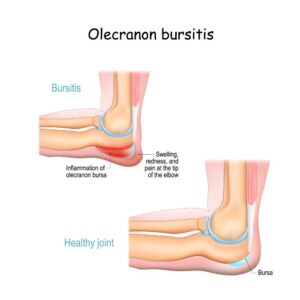
Any disruption or inflammation of this bursa, such as in the case of Olecranon Bursitis, can result in pain, swelling, and a limited range of motion. Prompt diagnosis and appropriate treatment are essential to address such issues and restore optimal function to the elbow joint.
If you’re suffering from Olecranon Bursitis, Dr Kirkham can offer you comprehensive and specialised care to alleviate your symptoms and facilitate your recovery. His intimate understanding of the anatomy and function of the Olecranon Bursa allows him to provide tailored treatment options that address the root cause of the issue, helping you regain comfort and restore normal function to your elbow.
Causes and Risk Factors of Bursitis
Olecranon Bursitis can be triggered by a range of different factors, with trauma being a common cause. Direct impact or injury to the back of the elbow, such as a fall or a blow, often leads to inflammation and irritation of the Olecranon Bursa. Prolonged pressure on the elbow, commonly seen in individuals who frequently rest their elbows on hard surfaces, can also contribute to the development of bursitis. The repetitive friction and compression on the bursa can cause it to become inflamed over time.
There are also certain risk factors that increase the likelihood of developing Olecranon Bursitis. Individuals in professions or activities that involve repetitive elbow movements, such as plumbers, carpenters, and athletes, are more prone to bursitis due to the increased stress placed on the joint. Aging can also be a contributing factor, as the bursa may become more susceptible to inflammation and degeneration over time. Underlying health conditions such as rheumatoid arthritis or gout can also heighten the risk of developing Olecranon Bursitis.
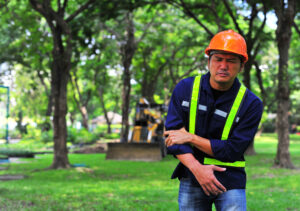
Understanding the causes and risk factors associated with Olecranon Bursitis is crucial in both the prevention and management of this condition. By identifying and addressing the underlying causes, it is possible to minimise the risk of developing bursitis or prevent its recurrence. For individuals in high-risk professions or those who engage in repetitive elbow movements, ergonomic adjustments and protective measures can be implemented to reduce excessive stress on the joint.
If you’ve been exposed to these risk factors and suffer from elbow pain, Dr Kirkham can undertake a thorough evaluation to identify the contributing factors and develop a treatment plan tailored to your unique situation. By capitalising on his great knowledge and commitment to providing exceptional care, you can expect your pain and symptoms to be alleviated, whilst also reducing the risk of further complications. Don’t let Olecranon Bursitis get the better of you. Reach out to Dr Kirkham today for a consultation to get your recovery started.
Symptoms and Identification of Bursitis
Olecranon Bursitis is characterised by a range of symptoms that can vary in intensity from mild to severe. The most common symptom of the condition is simply pain around the back of the elbow joint. This pain may be localised and exclusive to the area, or it may radiate to the surrounding areas. It can range from a dull ache to sharp, intense pain that worsens with movement or the exertion of pressure on the affected area.
Swelling is another prominent symptom of Olecranon Bursitis. When the condition arises, the bursa often becomes inflamed and may appear visibly swollen, leading to a noticeable bulge at the back of the elbow. When this occurs, the walls of the bursa can thicken, while the centre can become distended with various fluids – including serum, synovial fluid, pus or blood, and solid clumps of fibrin may also form. In some cases, the swelling can be accompanied by redness and warmth in the affected area.
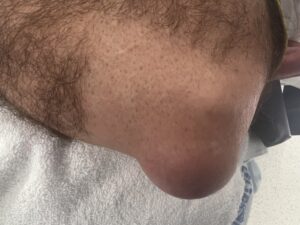
The symptoms of Olecranon Bursitis are generally very easy to identify as they have a significant impact on the patient’s daily life. They may notice discomfort when bending or straightening the arm, especially if pressure is applied to the back of the elbow. Simple activities such as lifting objects, gripping, or resting on the elbow may exacerbate the pain, and the bursa may be tender or sensitive to the touch. The individual’s range of motion within the elbow may also be more limited, making it even more difficult to perform their daily tasks
If you suspect that you’re experiencing the symptoms of Olecranon Bursitis, seeking medical attention from a specialist like Dr Stuart Kirkham is crucial. With his extensive knowledge and experience in treating orthopaedic conditions, Dr Kirkham can accurately diagnose the condition following a comprehensive assessment of your symptoms, medical history, and a physical examination. This will ensure an appropriate treatment plan is developed to alleviate your pain, reduce swelling, and promote healing.
Don’t let the symptoms of Olecranon Bursitis disrupt your daily life any longer. Schedule a consultation with Dr Stuart Kirkham to make sure you find relief from your symptoms and regain optimal function in your elbow joint.
Diagnosis and Imaging of Bursitis
The diagnosis of Olecranon Bursa typically involves a combination of a thorough physical examination and a detailed patient history. During the physical examination, Dr Kirkham will carefully assess the affected area, evaluating for signs of swelling, tenderness, warmth, and range of motion limitations. The examination may involve gentle palpation to identify the specific area of tenderness and assess the severity of the bursitis.
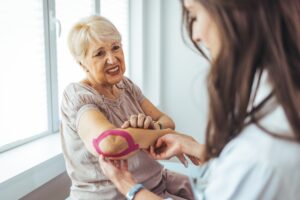
In addition to the physical examination, Dr Kirkham will also discuss the patient’s medical history to gain further insight into the patient’s individual circumstances. This involves questions about the symptoms and their duration, any previous injuries or trauma to the elbow, the occupational or recreational activities that may have contributed to the condition, and any underlying health conditions that could be associated with increased risk.
To further evaluate and confirm the diagnosis, Dr Kirkham often uses a range of imaging techniques. X-rays help Dr Kirkham identify any abnormalities and rule out other conditions that present with similar symptoms, such as fractures or arthritis. In some cases, magnetic resonance imaging (MRI) or ultrasound may also be required for a more thorough diagnosis. An MRI provides detailed images of the soft tissues, including the bursa, tendons, and surrounding structures, and this can help evaluate the extent of inflammation and assist in treatment planning. Ultrasound is another non-invasive imaging technique that can provide real-time images of the bursa, allowing for the visualisation of fluid accumulation, inflammation, and other changes.
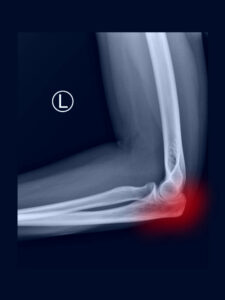
If you suspect you may be experiencing Olecranon Bursitis, seeking a professional diagnosis is crucial. Don’t hesitate to schedule a consultation with Dr Stuart Kirkham, who will guide you through the diagnostic process and provide expert advice and treatment options. By using a combination of physical examination, patient history, and appropriate imaging techniques, Dr Kirkham can accurately diagnose Olecranon Bursa issues and develop an individualised treatment plan tailored to your specific needs.
Treatment Options of Bursitis
When it comes to treating Olecranon Bursitis, non-surgical options are typically explored as the initial course of treatment. Resting the affected elbow joint is recommended to reduce inflammation following fluid build-up. By avoiding activities that exacerbate the pain and swelling, such as repetitive movements or placing pressure on the elbow, the bursa has an opportunity to heal.
Medications like nonsteroidal anti-inflammatory drugs (NSAIDs) may also be prescribed to manage pain and reduce inflammation. Physical therapy exercises targeting the elbow joint can also be beneficial in improving the patient’s range of motion, strengthening the surrounding muscles, and promoting healing.
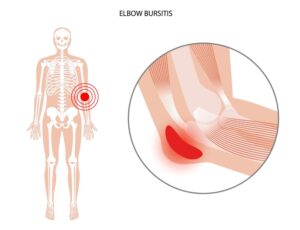
In cases where non-surgical interventions do not provide adequate relief or if the bursitis persists, surgical options may be considered. One such surgical procedure is bursectomy, which involves the removal of the inflamed bursa. This can be performed using traditional open surgery or minimally invasive techniques. Dr Kirkham has performed this surgery many times, and he often advocates for the surgery to address the underlying cause of the inflammation and work towards preventing the recurrence of bursitis.
Following surgical excision of the bursa, Dr Kirkham recommends a period of quiet rest for the elbow to allow for adequate skin healing. This typically involves avoiding activities that may strain the surgical site for about three weeks. It’s important to note that needle drainage procedures, which involve aspirating the fluid from the bursa, may provide temporary relief but do not address the underlying membrane housing the fluid. Therefore, there is a higher likelihood of bursitis recurrence with this method.
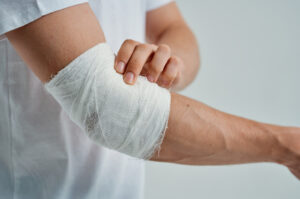
If you’re suffering from Olecranon Bursitis, Dr Kirkham will work closely with you to determine the most appropriate treatment option based on the severity of your conditions, your symptoms, and your individual needs. Whether non-surgical or surgical, the goal is to alleviate pain, reduce inflammation, and restore optimal function to your elbow joint, allowing you to resume your daily activities with improved comfort and mobility.
Prevention and Aftercare For Bursitis
A range of strategies can be employed to prevent the development of Olecranon Bursitis. Simple ergonomic changes to daily activities can play a significant role, such as the maintenance of proper posture and avoiding prolonged pressure or repetitive motions that strain the elbow joint. Supportive and cushioned equipment like padded elbow rests or gel-filled cushions can also help distribute pressure and reduce the risk of bursitis.
In professions or activities where repetitive elbow movements or increased risk of trauma is unavoidable, you may wish to use protective equipment where possible. Wearing elbow pads or braces can provide an extra layer of protection, absorbing impact and reducing the risk of direct injury to the bursa.

Aftercare following treatment for Olecranon Bursitis is vital for optimal recovery and to prevent recurrence. Adhering to prescribed medications, such as pain relievers or anti-inflammatory drugs, as directed by your healthcare provider, can help manage pain and reduce inflammation. Physical therapy also plays a crucial role in restoring strength, flexibility, and range of motion to the elbow joint, while home exercises and rehabilitation programs can support the healing process and prevent muscle imbalances. Maintaining a balanced diet and incorporating regular exercise can contribute to overall joint health and support healing. However, in severe cases, it may be necessary to completely avoid repetitive or strenuous motions that could aggravate the elbow joint.
By following preventive strategies and prioritising aftercare, you can significantly reduce the risk of developing Olecranon Bursitis and support the healing process if you have undergone treatment. Dr Stuart Kirkham is dedicated to providing comprehensive care and always offers guidance on preventive measures and tailored aftercare instructions. By incorporating these strategies into your lifestyle, you can promote long-term joint health and minimise the chances of bursitis recurrence, ensuring you live a more comfortable and active life.
The Recovery Process For Bursitis
The recovery process for Olecranon Bursitis can vary depending on the treatment approach, whether non-surgical or surgical. For non-surgical treatments, the timeline for recovery typically spans several weeks to months. It may involve a period of rest, followed by gradual reintroduction of activities as guided by Dr Kirkham. Pain and swelling should subside over time, and improvements in range of motion and strength can be expected with proper adherence to physical therapy exercises and lifestyle modifications to support the recovery process.

In the case of surgical treatment, the recovery timeline may also span several weeks to months. Following the surgical procedure, there will be a period of rest and restricted activities to allow for adequate healing of the surgical site. The initial phase of recovery focuses on wound healing, and the patient may need to wear a protective brace or splint to provide support. As the healing progresses, physical therapy will be gradually introduced to regain strength, flexibility, and range of motion.
It’s important to note that the length of the recovery period often differs between individuals and is influenced by a range of factors, including the patient’s age, overall health status and the presence of underlying conditions. However, all patients can a smoother recovery process when they follow their prescribed medication schedule, attend physical therapy sessions, and incorporate the recommended lifestyle modifications.
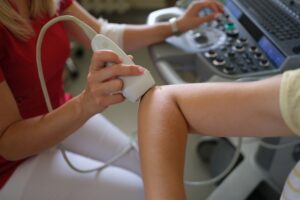
Dr Kirkham provides each patient with a detailed recovery plan based on their individual circumstances, and he monitors their progress closely, making any necessary adjustments to ensure the best possible outcome. By actively participating in the recovery process and closely following the recommended timeline and aftercare instructions, you’re more likely to experience a smooth and successful recovery from Olecranon Bursitis.
Possible Complications of Bursitis
If left untreated, Olecranon Bursa conditions can lead to several potential complications. One of the main risks is the progression of inflammation and swelling, which can result in chronic bursitis. Chronic bursitis can cause persistent pain, limited range of motion, and functional impairment in the affected elbow joint. This chronic inflammation may also lead to the formation of scar tissue, which can further restrict movement and contribute to ongoing discomfort.
In some cases, untreated Olecranon Bursitis can increase the risk of developing an infection in the bursa, known as septic bursitis. Bacteria can enter the bursa through a break in the skin or as a result of the bursa becoming contaminated. Septic bursitis can lead to more severe symptoms, including increased pain, redness, warmth, and common signs of infection such as fever and chills. If you suspect an infection has occurred, it’s important to seek medical attention to prevent the spread of infection and ensure more serious complications are not experienced.
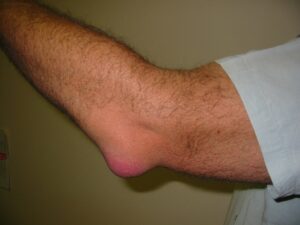
After Olecranon Bursitis has been treated, Dr Kirkham takes a number of precautions to minimise the chances of complications from arising. To reduce the risk of infection following surgery, Dr Kirkham adheres to a strict sterilisation schedule and always carefully explains proper wound care to the patient, providing detailed instructions for them to follow.
While there is a possibility of bursitis recurrence, this typically occurs if the underlying causes or risk factors are not adequately addressed. To prevent this, Dr Kirkham favours surgery when required and warns against the use of short-term measures, such as needling processes, which do not treat the root cause of the issue.
With great dedication and commitment to his patients, Dr Kirkham takes all the necessary steps to minimise the risk of complications associated with Olecranon Bursitis. He will closely monitor your condition, guide you through the treatment process, and provide appropriate recommendations to address potential complications and reduce the likelihood of recurrence. By seeking timely treatment and following the recommended aftercare, you can help prevent complications and work towards achieving the best possible outcome for your elbow joint health.
Are You Concerned About Olecranon Bursitis?
If you’re concerned about Olecranon Bursitis, rest assured that there are effective treatment options available to alleviate your symptoms and improve your quality of life. Non-surgical approaches such as rest, medications, and physical therapy have shown positive outcomes in many cases, providing relief from pain and reducing inflammation. These conservative treatments aim to promote healing and restore optimal function to your elbow joint.
However, if your symptoms worsen or persist despite conservative measures, or if you experience signs of infection such as increased pain, redness, or fever, you may wish to consult Dr Kirkham for specialised assistance. He will evaluate your condition, make an accurate diagnosis, and recommend appropriate interventions to address your specific needs.

With more than 25 years of experience as an orthopaedic surgeon, Dr Kirkham has treated numerous cases of bursitis, providing specialised care and achieving remarkable results. His knowledge, skill, and dedication ensure that you will receive the highest level of expertise and personalised treatment. Put your trust in Dr Kirkham and the team at the Sydney Orthopaedic Surgeon Clinic, and you’ll gain access to personalised guidance throughout your recovery. Dr Kirkham will provide reassurance, effective treatment options, and compassionate care to help you get your elbow health back on track. Take the first step towards a pain-free life by scheduling a consultation, and let Dr Kirkham help you regain comfort, mobility, and confidence in your elbow joint.
Frequently Asked Questions
1. Can I continue my regular activities if I have Olecranon Bursitis?
It is important to modify your activities to avoid exacerbating your symptoms and allowing the bursa to heal. Avoid activities that put excessive strain or pressure on the elbow joint, such as heavy lifting or repetitive movements. Resting the affected elbow and using protective equipment, such as elbow pads, can help minimise further irritation. For specific guidance tailored to your condition and lifestyle, be sure to ask for Dr Kirkham’s advice specific to your case.
2. How long does it take to recover from Olecranon Bursitis?
Recovery time can vary depending on the severity of the bursitis and the chosen treatment approach. Non-surgical treatments may require several weeks to months for symptoms to fully resolve, with gradual improvement over time. Surgical intervention, such as bursectomy, may involve a longer recovery period due to the need for wound healing and rehabilitation. Factors such as age, overall health status, and adherence to aftercare instructions can also affect the recovery timeline. When you consult Dr Kirkham, he will provide personalised guidance on your expected recovery time based on your individual situation.
3. Can Olecranon Bursitis recur after treatment?
Yes, there is a possibility of bursitis recurrence, particularly if underlying causes or risk factors are not addressed. To minimise the risk of recurrence, it is important to follow the recommended preventive strategies and aftercare instructions. This includes making ergonomic changes, using protective equipment when necessary, and maintaining a healthy lifestyle. Regular check-ups with Dr Kirkham are also important in helping him monitor your condition and address any potential signs of recurrence promptly.
4. Can I treat Olecranon Bursitis at home?
While some self-care measures can provide temporary relief, it is important to consult with a healthcare professional for an accurate diagnosis and appropriate treatment plan. Home remedies, such as applying ice packs, resting the affected elbow, and over-the-counter pain relievers, may help alleviate symptoms to some extent. However, it is crucial to seek medical attention to address the underlying cause and receive comprehensive treatment options tailored to your specific condition.
5. Can Olecranon Bursitis be prevented?
While it may not always be possible to prevent Olecranon Bursitis completely, certain preventive measures can reduce the risk. Avoiding prolonged pressure or repetitive movements that strain the elbow joint, maintaining proper ergonomics, and using protective equipment in high-risk activities can help minimise the likelihood of developing bursitis. Additionally, staying active, maintaining a healthy weight, and practicing good overall joint health can contribute to reducing the risk of bursitis. Consult with Dr Kirkham for personalised advice and strategies to help prevent or reduce the incidence of Olecranon Bursitis.
References
- Cleveland Clinic (Elbow (Olecranon) Bursitis)
- Mayo Clinic (Elbow Bursitis)
- Ortho Info (Elbow (Olecranon) Bursitis)
- American Society For Surgery of the Hand (Olecranon Bursitis)
- Emergency Care Institute (Elbow Bursitis)


